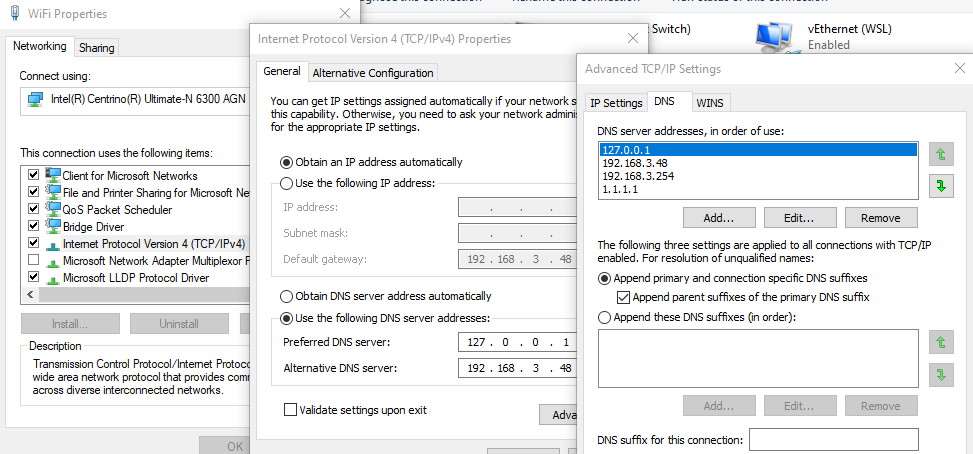Local Hostname Resolution To Port
It is not possible to make this work on 127.0.0.1, however the entire block 1278 is reserved for local loopback so any other 127.n.n.n address will work, more interesting reading about that on stackoverflow and in RFC 1700 :::
Hosts file Add a new entry for each service to the hosts file in C:\Windows\System32\drivers\etc\. ``` cmd 127.0.0.2 mailhog.internal 127.0.0.3 git.internal
``` ### Unbound Install Unbound. Add entries to service.conf by default on Windows that is in C:\Program Files\Unbound ### .local vs .localhost vs .test vs .internal
After reading round in circles about reserved TLDs such as rfc2606 which lists .test, .example, .invalid, .localhost as reserved domain names. This stackoverflow on best practices for internal domain and network names This TechNet article which goes back on previous advice about the use of .local and .internal.The risks of using my initial choice of .local due to possible clashes with mDNS and Zero Configuration Networking. Trying to use servicename.localhost with mixed results (works with hosts file but causes Unbound to throw and error and fail to start) and noticing that docker uses .internal I finally found RFC6762#appendix-G which lists .intranet., .internal., .private., .corp., .home. and .lan. as proposed reserved domain names, I settled on using .internal.
server: local-data: "mailhog.internal A 127.0.0.2" local-data-ptr: "127.0.0.2 mailhog.internal" local-data: "git.internal A 127.0.0.3" local-data-ptr: "127.0.0.3 git.internal" ``` Restart the service to make sure the new settings are used. Add `127.0.0.1` at the top of the list of DNS servers in network settings.  ## Add a netsh interface portproxy ```
netsh interface portproxy add v4tov4 listenport=80 listenaddress=127.0.0.2 connectport=8025 connectaddress=127.0.0.2 netsh interface portproxy add v4tov4 listenport=80 listenaddress=127.0.0.3 connectport=3005 connectaddress=127.0.0.3
or by domain name
netsh interface portproxy add v4tov4 listenport=80 listenaddress=mailhog connectport=8025 connectaddress=127.0.0.2 netsh interface portproxy add v4tov4 listenport=80 listenaddress=git.local connectport=3005 connectaddress=127.0.0.3
``` :::info
Between the 16 million loopback addresses and 65 thousand (48k usable according to [TCPIP number usage] and the Microsoft article [Port Exhaustion and You]) ports that leaves us a whole lot of services we can address on a single machine.
:::
I still need to figure out how this will work with IPv6 at the moment I only use IPv4 locally. I also need to understand the exact equivalence of `127.0.0.08` and `::1128`. netsh interface portproxy add v6tov4 listenport=80 listenaddress \\{IPv6Address | HostName\} \[connectaddress=] \\{IPv4Address | HostName\} \[[connectport=] \\{Integer | ServiceName\}] \[[listenaddress=] \\{IPv6Address | HostName\} \[[protocol=]tcp] Full [Network Shell (netsh) documentation](https:/docs.microsoft.comen-uswindows-servernetworkingtechnologiesnetshnetsh-interface-portproxy) on Microsoft docs. ## References
[Using port number in Windows host file]: https:/stackoverflow.coma/366467497400768
[TCPIP number usage]: https:/stackoverflow.comquestions113224what-is-the-largest-tcp-ip-network-port-number-allowable-for-ipv4
[Port Exhaustion and You]: https:/docs.microsoft.comen-usarchiveblogsaskdsport-exhaustion-and-you-or-why-the-netstat-tool-is-your-friend
